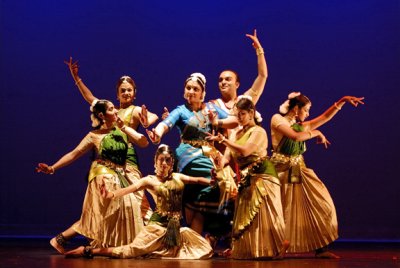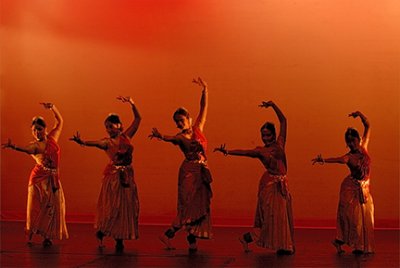 |
 |
Suryakantha
– a unique dance experience
May 29, 2006  The Samskriti Foundation's premiere of Suryakantha on April 9, 2006 at Pfeiffer Hall, North Central College in Naperville, Illinois, was an unusual and extraordinary South Indian classical dance performance. Suryakantha explores the bond of celestial love between the earth and sun through the varying seasons. Each season brings physical changes with emotional consequences. In summer, the earth swoons to the warm embrace of the sun. The warmth evokes the passion of a full-blown romance. During monsoon, the dark clouds create a tinge of insecurity. Autumn brings the first discordant notes into the relationship. The Earth is disconsolate and a well-meaning friend suggests that the Moon might be a less fickle suitor. In winter, the pangs of separation and loneliness become unbearable. Spring appears - the frost thaws, new life emerges, restoring shine to a love everlasting.  In Suryakantha,
this beautiful story was staged with incandescent genius. Samskriti's
artistic director, Shoba Natarajan, played the sensitive yet steadfast
Earth with dazzling dance movements and a subtle palette of emotions. Suryakantha
was choreographed by
There was crystalline precision in the group dances combining lively ensemble dancing with dramatic poses. The individual dances were delicately nuanced and many of the artistic touches lingered in memory for several days after the actual event. The Sun was portrayed with dignified gravity by Vinod Menon, who also conceived the unusual script and wrote the lyrics in chaste Sanskrit.
There were
many interesting and novel touches in the staging of Suryakantha. The lucid
English commentary was embedded into the soundtrack as a seamless part
of the performance. The props used were spare and the costume changes were
minimal and meaningful. There were no intervals, interruptions, or speeches,
which created a truly immersive audience experience. Both in the
sophisticated staging and the memorable artistic flourishes in the story,
script, and choreography, Suryakantha represents a landmark in the evolution
of classical Indian dance.
|